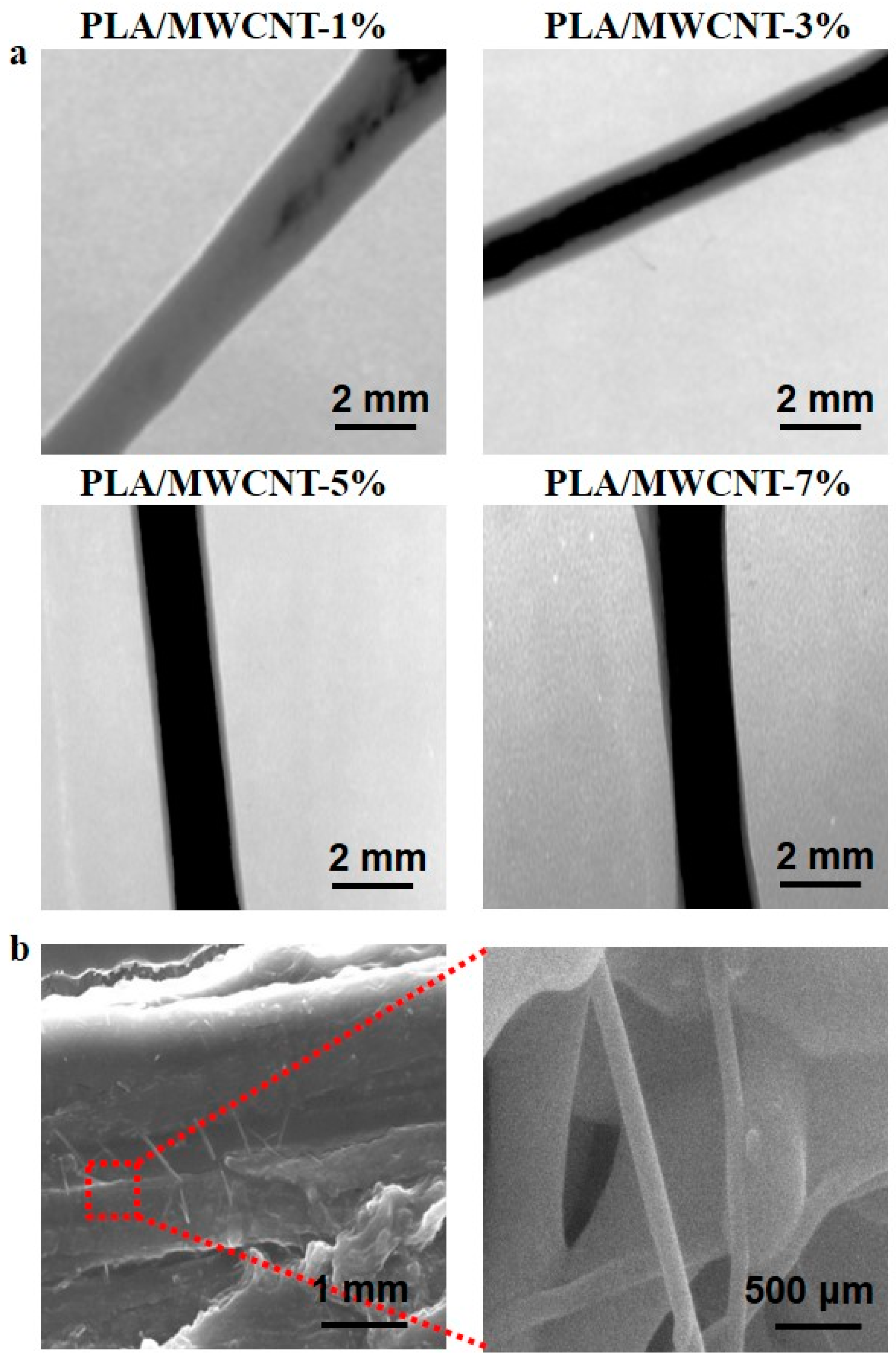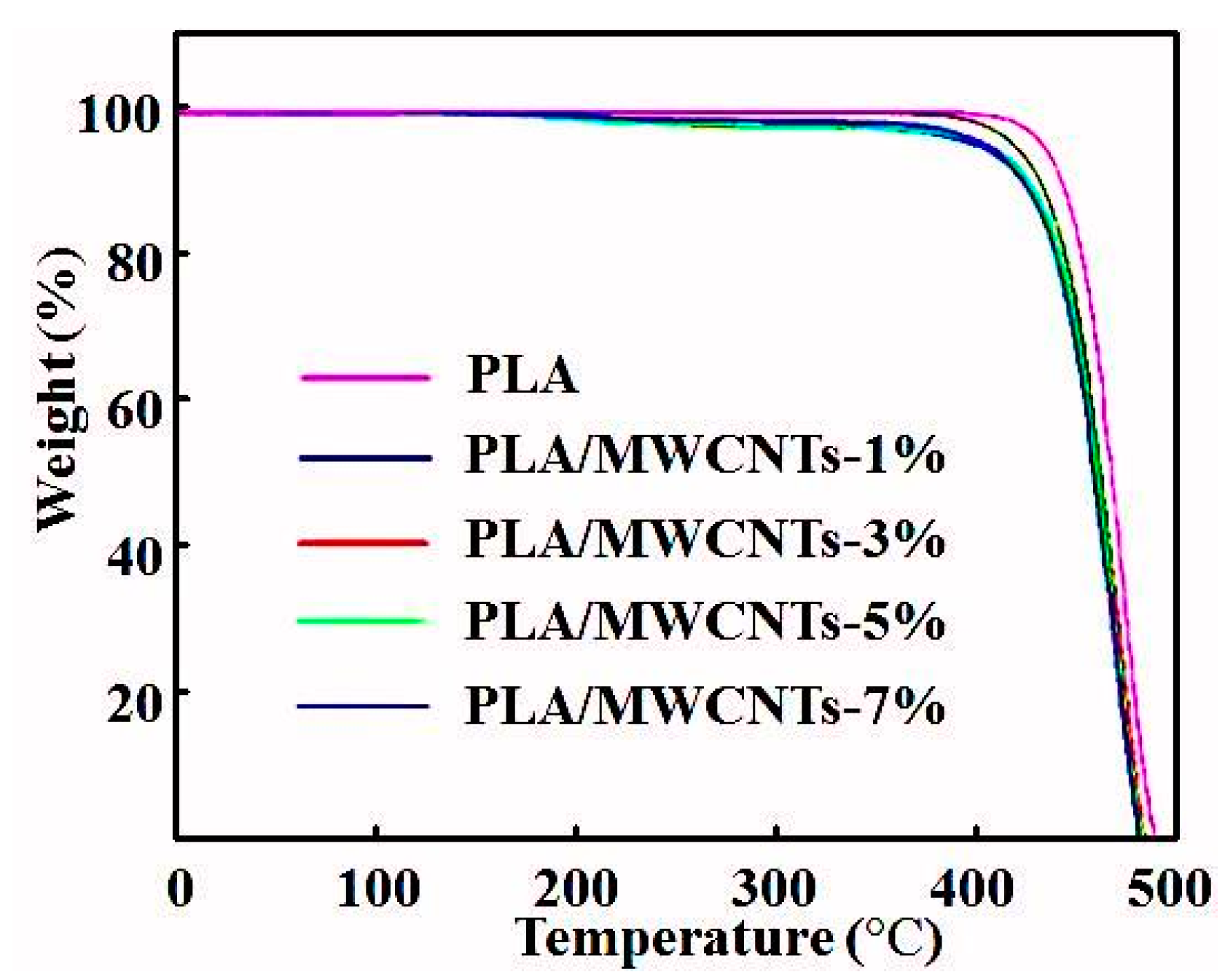Research on the Application of MWCNTs/PLA Composite Material in the Manufacturing of Conductive Composite Products in 3D Printing
Abstract
:1. Introduction
2. Materials and Methods
2.1. Materials
2.2. Preparation of the MWCNT/PLA Composite Material
2.3. 3D Printing of the MWCNT/PLA Composite Material
2.4. Composite Material Performance Test Method
2.5. Statistical Analysis
3. Results and Discussion
3.1. Dispersion of Materials
3.2. Electrical Conductivity of the Materials
3.3. Mechanical Properties and Application of the MWCNT/PLA Composite Materials
3.4. Analysis of Melt Flow Rate and Thermal Performance (MFR) of the MWCNT/PLA Composite Materials
3.5. Printing of Consumables and Printing Effect
4. Conclusions
Author Contributions
Funding
Conflicts of Interest
References
- Ngo, T.D.; Kashani, A.; Imbalzano, G.; Nguyen, K.T.Q.; Hui, D. Additive manufacturing (3D printing): A review of materials, methods, applications and challenges. Compos. Part. B-Eng. 2018, 143, 172–196. [Google Scholar] [CrossRef]
- Perrota, A.; Rangeardb, D.; Courteilleb, E. 3D printing of earth-based materials: Processing aspects. Constr. Build. Mater. 2018, 172, 670–676. [Google Scholar] [CrossRef]
- Hwa, L.C.; Rajoo, S.; Noor, A.M.; Ahmad, N.; Uday, M.B. Recent advances in 3D printing of porous ceramics: A review. Curr. Opin. Solid. State Mater. 2017, 21, 323–347. [Google Scholar] [CrossRef]
- Panthi, G.; Park, M.; Kim, H.Y.; Park, S.J. Electrospun polymeric nanofibers encapsulated with nanostructured materials and their applications: A review. J. Ind. Eng. Chem. 2015, 24, 1–13. [Google Scholar] [CrossRef]
- Staudinger, U.; Thoma, P.; Lüttich, F.; Janke, A.; Kobsch, O.; Gordan, O.D.; Thoma, P.; Pötschke, P.; Voit, B.; Zahn, D.R.T. Properties of thin layers of electrically conductive polymer/MWCNT composites prepared by spray coating. Compos. Sci. Technol. 2017, 138, 134–143. [Google Scholar] [CrossRef]
- Haggenmueller, R.; Gommans, H.H.; Rinzler, A.G.; Fischer, J.E.; Winey, K.I. Aligned single-wall carbon nanotubes in composites by melt processing methods. Chem. Phys. Lett. 2000, 330, 219–225. [Google Scholar] [CrossRef]
- Kumar, S.; Doshi, H.; Srinivasarao, M.; Park, J.O.; Schiraldi, D.A. Fibers from polypropylene/nano carbon fiber composites. Polymer 2002, 43, 1701–1703. [Google Scholar] [CrossRef]
- Brooker, R.D.; Guild, F.J.; Taylor, A.C. Quantifying the dispersion of carbon nanotubes in thermoplastic-toughened epoxy polymers. J. Mater. Sci. 2011, 46, 3108–3118. [Google Scholar] [CrossRef]
- Bethune, D.S.; Klang, C.H.; Vries, M.S.; Gorman, G.; Savoy, R.; Vazquez, J.; Beyers, R. Cobalt-catalysed growth of carbon nanotubes with single-atomic-layer walls. Nature 1993, 363, 605–607. [Google Scholar] [CrossRef]
- Romero, D.B.; Carrard, M.; Heer, W.D.; Zuppiroli, L. A carbon nanotube/organic semiconducting polymer heterojunction. Adv. Mater. 1996, 8, 899–902. [Google Scholar] [CrossRef]
- Gong, X.; Liu, J.; Baskaran, S.; And, R.D.V.; Young, J.S. Surfactant-assisted processing of carbon nanotube/polymer composites. Chem. Mater. 2016, 12, 1049–1052. [Google Scholar] [CrossRef]
- Shaffer, M.S.P.; Windle, A.H. Fabrication and characterization of carbon nanotube/poly(vinyl alcohol) composites. Adv. Mater. 1999, 1512, 320–321. [Google Scholar] [CrossRef]
- Zhang, Z.P.; Rong, M.Z.; Zhang, M.Q. Polymer engineering based on reversible covalent chemistry: A promising innovative pathway towards new materials and new functionalities. Prog. Polym. Sci. 2018, 80, 39–93. [Google Scholar] [CrossRef]
- Li, Y.Y.; Zhu, H.L.; Wang, Y.B.; Ray, U.; Zhu, S.Z.; Dai, J.Q.; Chen, C.J.; Fu, K.; Jang, S.; Henderson, D.; et al. Cellulose-nanofiber-enabled 3d printing of a carbon-nanotube microfiber network. Small Methods 2017, 1. [Google Scholar] [CrossRef]
- Pucci, J.U.; Christophe, B.R.; Sisti, J.A.; Connolly, E.S. Three-dimensional printing: Technologies, applications, and limitations in neurosurgery. Biotechnol. Adv. 2017, 35, 521–529. [Google Scholar] [CrossRef] [PubMed]
- Guerra, M.G.; Volpone, C.; Galantucci, L.M.; Percoco, G. Photogrammetric measurements of 3D printed microfluidic devices. Addit. Manuf. 2018, 21, 53–62. [Google Scholar] [CrossRef]
- Fina, F.; Goyanes, A.; Gaisford, S.; Basit, A.W. Selective laser sintering (SLS) 3D printing of medicines. Int. J. Pharmaceut. 2017, 529, 285–293. [Google Scholar] [CrossRef] [PubMed]
- Somireddy, M.; Czekanski, A.; Singh, C.V. Development of constitutive material model of 3D printed structure via FDM. Mater. Today Commun. 2018, 15, 143–152. [Google Scholar] [CrossRef]
- Zhao, F.; Shi, Y.; Pan, L.; Yu, G. Multifunctional nanostructured conductive polymer gels: Synthesis, properties, and applications. Acc. Chem. Res. 2017, 50, 1734–1743. [Google Scholar] [CrossRef] [PubMed]
- Song, Y.; Yang, Z.; Liu, Y.; Deng, J. Function representation based slicer for 3d printing. Comput. Aided Geom. Des. 2018. [Google Scholar] [CrossRef]
- Liu, Y.W.; Lu, J.; Xu, G.; Wei, J.; Zhang, Z.; Li, X. Tuning the conductivity and inner structure of electrospun fibers to promote cardiomyocyte elongation and synchronous beating. Mater. Sci. Eng. C-Mater. 2016, 1, 865–874. [Google Scholar] [CrossRef] [PubMed]
- Liu, Y.W.; Liang, X.; Wang, S.Y.; Hu, K. Electrospun poly(lactic-co-glycolic acid)/multiwalled carbon nanotube nanofibers for cardiac tissue engineering. J. Biomater. Tissue Eng. 2016, 6, 719–728. [Google Scholar] [CrossRef]
- Gug, J.; Sobkowicz, M.J.; Soule, J.; Tan, B. Effects of chain-extending stabilizer on bioplastic poly(lactic acid)/polyamide blends compatibilized by reactive extrusion. Polym. Degrad. Stab. 2018. [Google Scholar] [CrossRef]
- Brown, T.D.; Dalton, P.D.; Hutmacher, D.W. Melt electrospinning today: An opportune time for an emerging polymer process. Prog. Polym. Sci. 2016, 56, 116–166. [Google Scholar] [CrossRef]
- Liu, Y.W.; Wang, S.Y.; Lan, W.T. Fabrication of antibacterial chitosan-PVA blended film using electrospray technique for food packaging applications. Int. J. Biol. Macromol. 2017, 107, 848–854. [Google Scholar] [CrossRef] [PubMed]
- Matsuzaki, K.; Hatsukano, K.; Hanada, K.; Shimizu, T.; Sano, T. Microstructure and mechanical properties of hot-extruded az31 powders. Mater. Sci. Forum 2013, 6, 426–432. [Google Scholar] [CrossRef]
- Hashemi, S.R.; Campagne, C.; Nierstrasz, V. Investigation of the adhesion properties of direct 3D printing of polymers and nanocomposites on textiles: Effect of FDM printing process parameters. Appl. Surf. Sci. 2017, 403, 551–563. [Google Scholar] [CrossRef]
- Wang, S.M.; Sun, C.X.; Guo, W.H.; Ge, C.C.; Yan, Q.Z.; Zhou, Q.; Chen, P.W.; Chen, Z.B. Modifying the properties of tungsten based plasma facing materials with single-wall carbon nanotubes. J. Mater. Sci. Technol. 2013, 29, 919–922. [Google Scholar] [CrossRef]
- Curran, S.; Davey, A.P.; Coleman, J.; Dalton, A.; Mccarthy, B.; Maier, S.; Drury, A.; Gray, D.; Brennan, M.; Ryder, M.; et al. Evolution and evaluation of the polymer/nanotube composite. Synth. Met. 1999, 103, 2559–2562. [Google Scholar] [CrossRef]
- Deng, H.; Skipa, T.; Bilotti, E.; Zhang, R.; Lellinger, D.; Mezzo, L.; Fu, Q.; Alig, I.; Peijs, T. Preparation of high-performance conductive polymer fibers through morphological control of networks formed by nanofillers. Adv. Funct. Mater. 2010, 20, 1424–1432. [Google Scholar] [CrossRef]
- Patrick, F.F.; Christopher, R.; Shengrong, Y.; Myung, J.K.; Benjamin, J.W. 3D printing electronic components and circuits with conductive thermoplastic filament. Addit. Manuf. 2017, 18, 156–163. [Google Scholar]
- Li, Z.; Tan, B.H.; Lin, T.; He, C. Recent advances in stereocomplexation of enantiomeric PLA-based copolymers and applications. Prog. Polym. Sci. 2016, 62, 22–72. [Google Scholar] [CrossRef]
- Coleman, J.N.; Khan, U.; Blau, W.J.; Gun’Ko, Y.K. Small but strong: A review of the mechanical properties of carbon nanotube–polymer composites. Carbon 2006, 44, 1624–1652. [Google Scholar] [CrossRef]
- Qian, D.; Dickey, E.C.; Andrews, R.; Rantell, T. Load transfer and deformation mechanisms in carbon nanotube-polystyrene composites. Appl. Phys. Lett. 2000, 76, 2868–2870. [Google Scholar] [Green Version]
- Yang, K.; Gu, M.; Guo, Y.; Pan, X.; Mu, G. Effects of carbon nanotube functionalization on the mechanical and thermal properties of epoxy composites. Carbon 2009, 47, 1723–1737. [Google Scholar] [CrossRef]
- Carson, L.; Kellybrown, C.; Stewart, M.; Oki, A.; Regisford, G.; Luo, Z.; Bakhmutov, V.I. Synthesis and characterization of chitosan-carbon nanotube composites. Mater. Lett. 2009, 63, 617–620. [Google Scholar] [CrossRef] [PubMed]
- Michel, F.M.; Rimstidt, J.D.; Kletetschka, K. 3d printed mixed flow reactor for geochemical rate measurements. Appl. Geochem. 2017, 89, 86–91. [Google Scholar]
- Tian, X.; Liu, T.; Yang, C.; Wang, Q.; Li, D. Interface and performance of 3d printed continuous carbon fiber reinforced PLA composites. Compos. Part. A-Appl. 2016, 88, 198–205. [Google Scholar] [CrossRef]
- Chen, P.Y.; Lian, H.Y.; Shih, Y.F.; Chen-Wei, S.M.; Jeng, R.J. Preparation, characterization and crystallization kinetics of kenaf fiber/multi-walled carbon nanotube/polylactic acid (PLA) green composites. Mater. Chem. Phys. 2017, 196, 249–255. [Google Scholar] [CrossRef]






| Properties | PLA | PVA/MWCNT-1% | PVA/MWCNT-3% | PVA/MWCNT-5% | PVA/MWCNT-7% |
|---|---|---|---|---|---|
| Stress (MPa) | 18.8 ± 2.1 | 44.7 ± 8.4 | 67.2 ± 10.3 | 78.4 ± 12.4 | 72.2 ± 11.4 |
| Strain (%) | 26.2 ± 3.4 | 78.6 ± 12.7 | 90.1 ± 13.3 | 94.4 ± 14.3 | 91.9 ± 13.8 |
| Young’s Modulus | 78.4 ± 10.3 | 108.5 ± 17.4 | 127.6 ± 21.0 | 134.4 ± 24.3 | 114.8 ± 18.2 |
| Samples | MFR(g/10 min) |
|---|---|
| PLA | 18.8 ± 2.3 |
| PVA/MWCNT-1% | 20.0 ± 2.8 |
| PVA/MWCNT-3% | 24.4 ± 3.1 |
| PVA/MWCNT-5% | 27.5 ± 3.9 |
| PVA/MWCNT-7% | 8.6 ± 1.2 |
© 2018 by the authors. Licensee MDPI, Basel, Switzerland. This article is an open access article distributed under the terms and conditions of the Creative Commons Attribution (CC BY) license (http://creativecommons.org/licenses/by/4.0/).
Share and Cite
Luo, J.; Wang, H.; Zuo, D.; Ji, A.; Liu, Y. Research on the Application of MWCNTs/PLA Composite Material in the Manufacturing of Conductive Composite Products in 3D Printing. Micromachines 2018, 9, 635. https://doi.org/10.3390/mi9120635
Luo J, Wang H, Zuo D, Ji A, Liu Y. Research on the Application of MWCNTs/PLA Composite Material in the Manufacturing of Conductive Composite Products in 3D Printing. Micromachines. 2018; 9(12):635. https://doi.org/10.3390/mi9120635
Chicago/Turabian StyleLuo, Jinjie, Haibao Wang, Duquan Zuo, Anping Ji, and Yaowen Liu. 2018. "Research on the Application of MWCNTs/PLA Composite Material in the Manufacturing of Conductive Composite Products in 3D Printing" Micromachines 9, no. 12: 635. https://doi.org/10.3390/mi9120635




